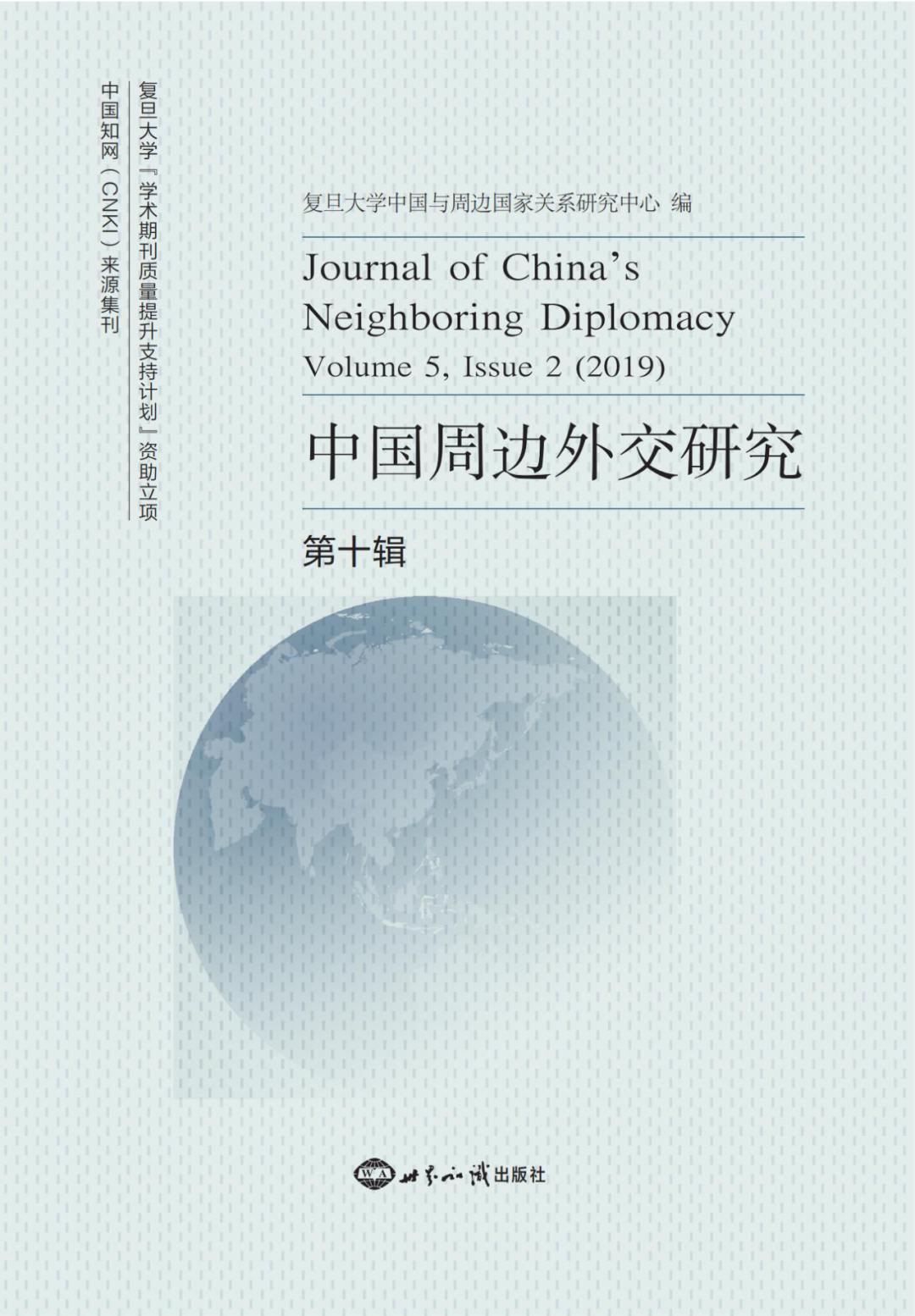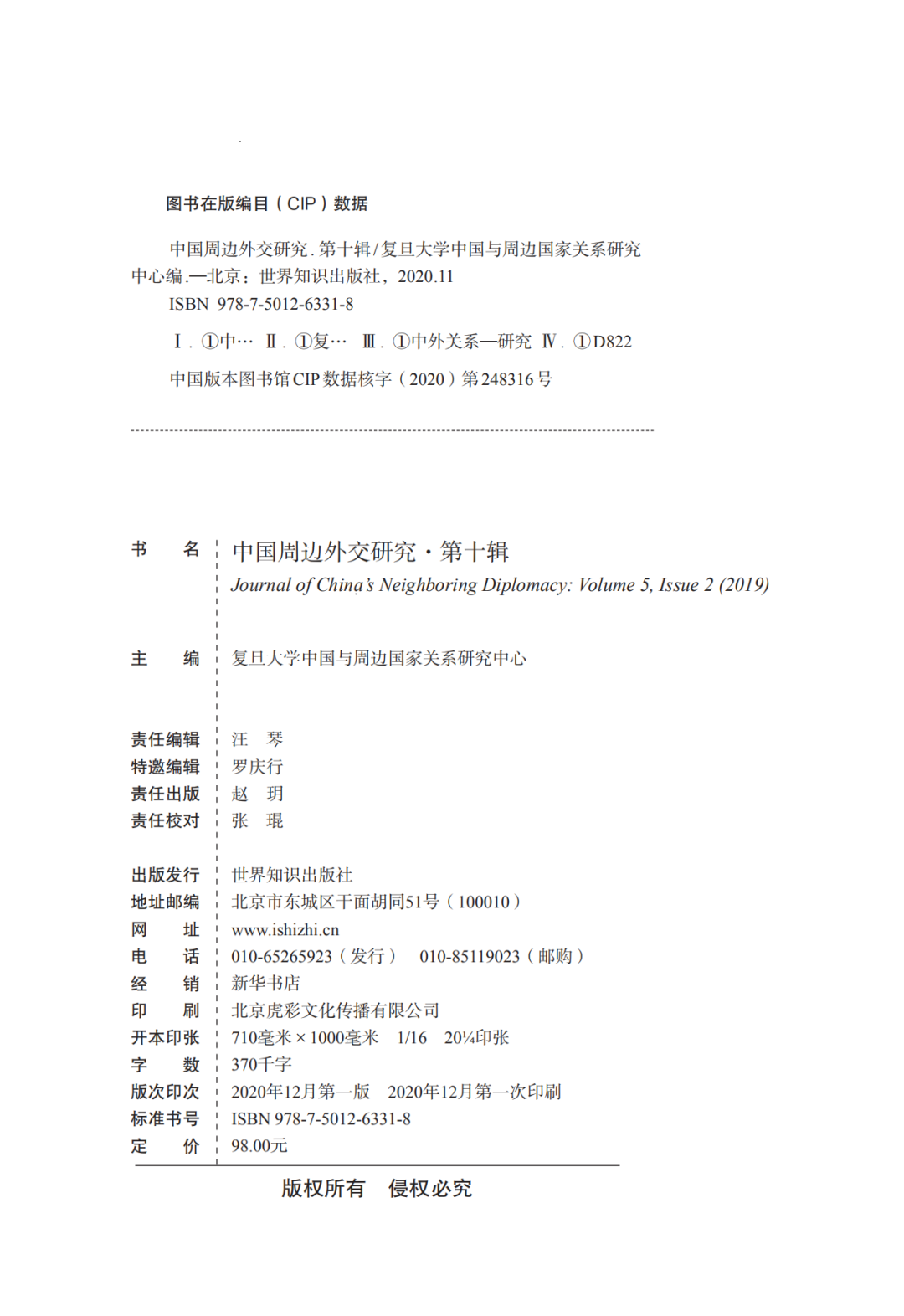 |  |
| The Title Page of Journal of China's Neighboring Diplomacy, Vol. 5, Issue 2 (2019) | The Copyright Page of Journal of China's Neighboring Diplomacy, Vol. 5, Issue 2 (2019) |
Center for China's Relations with Neighboring Countries of Fudan University (CCRNC-Fudan), ed, Journal of China's Neighboring Diplomacy, Vol. 5, Issue 2, 2019.
Publisher: World Affairs Press (China)
Published in December 2020.
ISBN: 978-7-5012-6331-8
Contents
Preface...... Qi Huaigao / 1
China's Neighboring Diplomacy in the past 70 Years II
On Historical Evolution of China's Neighboring Diplomacy in the Past 70 Years...... Shi Yuanhua / 11
History, Characteristics and Challenges of China's Diplomacy to Russia (Soviet Union) in the Past 70 Years...... Li Yonghui / 25
Reviewing China's Diplomacy to Southeast Asia in the Past 70 Years...... Zhao Weihua / 48
Seventy Years of China's Diplomacy toward South Asia: History, Challenges and Prospects...... Lin Minwang / 72
Comprehensive Studies on China's Neighboring Diplomacy
Progress, Deficiency and Improvement of Asia-Pacific Regional Security Architecture...... Tang Yongsheng and Fang Ke / 197
Studies on Belt & Road Initiative
China-Pakistan Economic Corridor Construction: Summary of the Previous Stage and Reflection on the New Stage...... Liu Zongyi /119
Coordination of the 21st-Century Maritime Silk Road and Sri Lanka's "Vision 2025"...... Qi Huaigao / 139
Background and Path of Building Energy Cooperation Community of "China-Central Asia-West Asia Economic Corridor"...... ZhuYongbiao and Miao Xiaoyang / 151
China's Neighboring Countries Studies Report IV
On China's Neighboring Countries Studies...... Zhang Liheng/ 169
The Inspirations of EU Peripheral Governance to the Construction of China's Neighboring Countries Studies...... Song Lilei / 172
The Inspirations from Remoteness to Proximity: The Reference to the Studies of China's Neighboring Countries from the Studies of European Integration...... Xin Hua / 177
Constructing Theoretical System of the Studies of China's Neighboring Countries: States, Regional organizations and Regional Governance...... Liu Qingyao / 183
Controversy and Advancement: Similarities and Commonness in China's Neighboring Countries Studies and Regional Country Studies...... Zhang Li / 187
China's Neighboring Countries Studies from the Perspective of China: Standing Up, Getting Rich, and Growing Strong...... Ye Shengxuan / 193
Hot Issues in China's Neighboring Areas
On the Institutional Building of the Lancang-Mekong Cooperation...... Li Fujian and Guo Yanjun / 199
Study on China's Neighboring Countries
Evolution and Impact of South Korean Maritime Security Strategy after the Cold War...... Yang Luhui and Zhu Dina / 219
Hedging Strategy: Japan's Shifting Foreign Policy to China...... Mong Cheung / 237
Research Report
Cooperative Research Report on Joint Development in the South China Sea: Incentives, Policies & Ways Forward...... Qi Huaigao, Xue Song, Jolene H. Y. Liew, Evi Fitriani, Ngeow Chow Bing, Aaron Jed Rabena, Bui Thi Thu Hien, Hong Nong / 253
Book Review
Power, Principles and Facts in the South China Sea Disputes: Review On The South China Sea Disputes between China and Vietnam from the Power Diffusion Perspective..... Ma Jianying / 273
Reviews on Symposiums
Review on the Roundtable of Creative Thinking and Practical Policies of Joint Development in the South China Sea...... Dong Yi / 283
Review on the Indonesian Politics Roundtable Joko Widodo Administration's Performance and the 2019 General Election...... Yang Zhe and Xue Song / 289
Appendix
Introduction on Center for China's Relations with Neighboring Countries of Fudan University (CCRNC-Fudan) / 297
Notice Inviting Contributions to the journal of China s Neighboring Diplomacy / 299
Standards of Articles and Annotations of the Journal of China's Neighboring Diplomacy /301
On Historical Evolution of China’s Neighboring Diplomacy in the Past 70 Years
SHI Yuanhua
Abstract: China’s neighboring diplomacy in the past 70 years has been influenced and restricted by the international pattern, feature of times and the changing neighboring situation. It has also been closely connected with Chinese policymakers’ subjective understanding of the international situation, global strategy and diplomacy, which forms 7 changing stages of 3 historical eras. During the Mao Zedong era when China just stood up, 3 changing stages can be summarized as “Uniting with the Soviet Union Against the US”, “Anti the Soviet Union and the US” and “Uniting with the US Against the Soviet Union”. During the Deng Xiaoping / Jiang Zemin / Hu Jintao era when China grew rich, 3 changing stages can be summarized as “No Alliance with Any Big Power”, “Omni-directional Diplomacy” and “Transition towards Major Country”. During the Xi Jinping era when China becomes strong, China enters in the stage of “Major Country Diplomacy”. Such constant evolution reflects the development of China’s national power and the changing neighboring environment. It also shows that China’s neighboring diplomacy has gradually become mature amidst difficulties. Studying and summarizing the historical evolution of China’s neighboring diplomacy in the past 70 years has both theoretical and practical significance for recognizing the new thinking, new strategy and new path of China’s neighboring diplomacy in the new era.
Keywords: New China; Neighboring diplomacy; Historical evolution
Author: Shi Yuanhua, Distinguished Professor of Fudan University, Ph. D. Tutor, Former Director of the Center for China’s Relations with Neighboring Countries at Fudan University
Official Citation: Shi Yuanhua, On Historical Evolution of China’s Neighboring Diplomacy in the Past 70 Years, Journal of China’s Neighboring Diplomacy, Vol. 5, Issue 2, 2019, pp. 11-24.
History, Characteristics and Challenges of China’s Diplomacy to Russia (Soviet Union) in the Past 70 Years
LI Yonghui
Abstract: Sino-Soviet relations had gone through ups and downs, undergoing the most severe challenges between two sovereign countries from the perspective of international relations, namely from alliance, confrontation to division. After the collapse of the Soviet Union, China and Russia have built a new model of major country relations, which refers to mutual respect, equal treatment, non-aligned, non-confrontational, non-third party oriented, non-ideological, win-win cooperation, friendship from generation to generation and never turning against each other. For now, China-Russia comprehensive strategic partnership of coordination is at its best in history. China and Russia are faced with new opportunities and new responsibilities in the new era, and at the same time should properly manage issues like the existing mutual trust issues, China’s impact on Central Asia and challenges from the U.S., etc.
Keywords: China’s Diplomacy to Russia; Sino-Soviet relations; China-Russia relations; China-Russia-America relations
Author: Li Yonghui, Vice Director and Researcher at Institute of Russian, Eastern European & Central Asian Studies, Chinese Academy of Social Sciences.
Official Citation: Li Yonghui, History, Characteristics and Challenges of China’s Diplomacy to Russia (Soviet Union) in the Past 70 Years, Journal of China’s Neighboring Diplomacy, Vol. 5, Issue 2, 2019, pp. 25-47.
Reviewing China’s Diplomacy to Southeast Asia in the Past 70 Years
ZHAO Weihua
Abstract: Southeast Asia is located at the intersection of maritime and continental silk road, controlling the vital communication line from China to South Pacific, Indian Ocean and Europe. Southeast Asia is of great geo-strategic significance among China’s neighboring regions. After the 18th National Congress of the Communist Party of China, with the proposal of Belt & Road Initiative (BRI) and the strategic conception of a community with a shared future for mankind, China’s neighboring diplomacy has achieved strategic promotion in status. The aforesaid conception not only indicates that China has become the second largest economy in the world, but also marks that China has grown as the setter and rulemaker of the international social political agenda, as well as the participant of global and regional governance. Thus, China is in fact a major country in the international system. As a significant direction of China’s neighboring diplomacy, Southeast Asia has an irreplaceable strategic position in promoting BRI and building a community of shared future for China and its neighboring countries, providing new opportunities for China to advance neighboring diplomacy in the new era, while at the same time generates various challenges for China to resolve with new strategic way of thinking.
Keywords: Neighboring diplomacy; Southeast Asia; Belt & Road Initiative; Community of shared future; Rise of China
Author: Zhao Weihua, Ph. D., Professor at Guangdong Institute for
International Studies, Guangdong University of Foreign Studies, Master tutor.
Official Citation: Zhao Weihua, Reviewing China’s Diplomacy to Southeast Asia in the Past 70 Years, Journal of China’s Neighboring Diplomacy, Vol. 5, Issue 2, 2019, pp. 48-71.
Seventy Years of China’s Diplomacy toward South Asia: History, Challenges and Prospects
LIN Minwang
Abstract: China’s diplomacy to South Asia in the past 70 years went through four stages the first stage (1949-1962): China attached more importance to India and less to Pakistan while establishing diplomatic ties with other South Asian countries; the second stage (1963-1978): China allied with Pakistan to act against India; the third stage (1979-2012): the emphasis of China’s diplomacy to South Asia was gradually switched to China’s domestic issues, forming the diplomacy of "balance between India and Pakistan"; the forth stage ( since 18th National Congress of the Communist Party of China in 2012): China diplomacy to South Asia starts to pursue new conception such as promoting Belt & Road Initiative (BRI), while encounters new geopolitical challenges. In the future situation of South Asia region, India will be marked by its regional supremacy, and the U.S. and other major countries outside of the region will be deeply involved in the regional issues. The regional relations within South Asia will be faced with series of reshaping, in which China will be playing a more important role. China’s diplomacy to South Asia ought to expand way of thinking under the new situation through setting diplomacy to India as the key of South Asian strategy, regarding "balance between India and Pakistan" as the basic principle of South Asian strategy, and pursuing the integration of BRI and regional connectivity programs so as to proactively advance China’s diplomacy to South Asia on multilateral platforms.
Keywords: China’s diplomacy to South Asia; Balance between India and Pakistan; Belt & Road Initiative; Indo-Pacific strategy
Author: Lin Minwang, Professor, Deputy Director of the Center for South Asian Studies and Assistant to Dean of the Institute of International Studies at Fudan University.
Official Citation: Lin Minwang, Seventy Years of China’s Diplomacy toward South Asia: History, Challenges and Prospects, Journal of China’s Neighboring Diplomacy, Vol. 5, Issue 2, 2019, pp. 72-94.
Progress, Deficiency and Improvement ofAsia-Pacific Regional Security Architecture
TANGYongsheng and FANG Ke
Abstract: The Asia-Pacific region has established a regional security architecture with multi-layered interactions and functional goals. At the same time, the security products that the existing security architecture can provide are not sufficient, coupled with the multiple and complex issues that need to be resolved, the existing organizational form being loose and diverse, and the continuous convergence of security risks that need to be improved and expanded in dynamic adjustments must be effectively relieved. However, with the evolution of the regional security situation and the development of changes in national interests and security needs, the inherent demand for security architecture in the Asia-Pacific region has become clearer and stronger. During the process of building a regional security architecture, China needs to take greater responsibility. China’s path to build the security architecture in the Asia-Pacific region: based on common interests and driven by incremental benefits, actively promote transform in regional security mechanisms; China as the main force in navigating the development of China-US rivalry; actively plan for China-US-Japan-India relations between major powers and relieve the pressure from the strengthening alliance system of the US; pay more attention to improving the regional security architecture with the improvement of national governance.
Keywords: Asia-Pacific region; Security Architecture; Security deficit; Rivalry among major countries; Incremental benefits
Author:s Tang Yongsheng, Professor at School of National Security, National Defence University of People’s Liberation Army of China; Fang Ke, Associate Professor at School of National Security, National Defence University of People’s Liberation Army of China.
Official Citation: Tang Yongsheng and Fang Ke, Progress, Deficiency and Improvement of Asia-Pacific Regional Security Architecture, Journal of China’s Neighboring Diplomacy, Vol. 5, Issue 2, 2019, pp. 97-115.
China-Pakistan Economic Corridor Construction: Summary of the Previous Stage and Reflection on the New Stage
LIU Zongyi
Abstract: The China-Pakistan Economic Corridor is known as the flagship and pilot project of the Belt and Road Initiative. With the joint efforts of China and Pakistan, significant progress has been made in the construction of the China- Pakistan Economic Corridor over the past six years. However, due to various reasons, the construction speed is much slower than expected by the two countries. At present, the construction of the China-Pakistan Economic Corridor has entered a new stage of high-quality development. In the past six years, the construction of the China-Pakistan Economic Corridor has encountered a series of obstacles and challenges. In the new phase of construction, these obstacles and challenges still exist, and new challenges may emerge. China should realize that the corridor construction cannot proceed as fast as the original agenda. China ought to clearly define the position of the China-Pakistan Economic Corridor, and first change its conception so as to promote the construction.
Keywords: China-Pakistan Economic Corridor; Belt and Road Initiative; New phase
Author: Liu Zongyi, Associate Research Fellow at the Institute for International Strategic Studies and Centre for Asia-Pacific Studies, Secretary General of China and South Asia Cooperation Research Center, Shanghai Institutes for International Studies (SIIS).
Official Citation: Liu Zongyi, China-Pakistan Economic Corridor Construction: Summary of the Previous Stage and Reflection on the New Stage, Journal of China’s Neighboring Diplomacy, Vol. 5, Issue 2, 2019, pp. 119-138.
Coordination of the 21st-Century Maritime Silk Road and Sri Lanka’s "Vision 2025"
QI Huaigao
Abstract: Sri Lanka is located at the Indian Ocean maritime trade center and the East-West economic and cultural intersection. It is an important country along the 21st Century Maritime Silk Road. In September 2017, the National Solidarity Government of Sri Lanka proposed an 8-year economic development plan called Vision 2025. Vision 2025 is to make Sri Lanka a rich country by 2025, and to make Sri Lanka a knowledge-based, highly competitive social market economy. To promote the docking of the 21st Century Maritime Silk Road with Sri Lanka’s Vision 2025, the two countries can focus on the Colombo Port City Project, the Hambantota Port Cooperation Project, the Hambantota China-Sri Lanka Industrial Park Construction, and the China-Sri Lanka Free Trade Zone negotiation. China and Sri Lanka’s development strategy integration also faces challenges: First, Sri Lanka is facing increasing external debt risk, which provokes debt anxiety towards Chinese investment. China needs to adjust its investment model to help Sri Lanka economy form a sustainable "blood-making" capacity. Second, the sociopolitical situation in Sri Lanka has deteriorated to some extent in recent years. Chinese enterprises in Sri Lanka need to raise risk-prevention awareness, and pay attention to the protection of personal and property security. Third, India has become a key factor influencing the development of China-Sri Lanka economic cooperation. China needs to stay alert to the possible negative effects India might cause, while being open to the participation of Indian enterprises in Sri Lanka’s infrastructure construction.
Keywords: the 21st-Century Maritime Silk Road; Vision 2025; China; Sri Lanka; Coordination of Development Strategies
Author: Qi Huaigao, Vice Dean and Associate Professor at Fudan University’s Institute of International Studies.
Official Citation: Qi Huaigao, Coordination of the 21st-Century Maritime Silk Road and Sri Lanka’s "Vision 2025", Journal of China’s Neighboring Diplomacy, Vol. 5, Issue 2, 2019, pp. 139-150.
Background and Path of Building Energy Cooperation Community of “China-Central Asia-West Asia Economic Corridor”
ZHU Yongbiao and MIAO Xiaoyang
Abstract: Relying on the "China-Central Asia-West Asia Economic Corridor", strengthening energy cooperation with relevant countries in all directions, coping with profound adjustment and significant changes in the international energy pattern, striving to build a new energy cooperation community and realizing energy security under open conditions have become the top priority and key direction of China’s energy policy. As a systematic project, the construction of the “China-Central Asia- West Asia Economic Corridor” energy cooperation community should innovate the energy cooperation mode, expand the field of energy cooperation, and enrich the types and modes of energy cooperation on the basis of cultivating the awareness of building the energy cooperation community. China should play a constructive role in the mode selection, framework system construction, system process design, organization, coordination and operation mechanism establishment, fund raising and other aspects of the energy community.
Keywords: China-Central Asia-West Asia Economic Corridor; Energy Cooperation Community; Energy Security
Authors: Zhu Yongbiao, Professor and Director of the Center for Afghanistan studies of Lanzhou University; Miao Xiaoyang, graduate candidate at School of Politics and International Relations, Lanzhou University.
Official Citation: Zhu Yongbiao and Miao Xiaoyang, Background and Path of Building Energy Cooperation Community of "China-Central Asia-West Asia Economic Corridor”, Journal of China’s Neighboring Diplomacy, Vol. 5, Issue 2, 2019, pp. 151-166.
On the Institutional Building of the Lancang-Mekong Cooperation
LI Fujian and GUO Yanjun
Abstract: Since its establishment three years ago, the Lancang-Mekong Cooperation (LMC) has achieved fruitful results in many areas of practical cooperation. The institutionalization level of the mechanism itself has also been continuously improved. Six participating countries have successively established national secretariats or coordinating bodies. However, these discrete national implementing agencies are unable to plan in an integrated manner from the overall perspective of the Lancang-Mekong sub-region, nor have the right to formulate laws and regulations to ensure the effective implementation of cooperat妬n initiatives, nor can they smoothly coordinate with other international organizations in the region. In this context, it is necessary to explore the necessity and feasibility of establishing a LMC international secretariat. By sorting out and analyzing public opinions of Mekong countries, and conducting interviews and questionnaires with relevant think-tankers and officials, this study aims to understand the basic attitudes and responses of member countries towards the establishment of the international secretariat. The study also draws on the experience and methods of the secretariats of other international organizations to put forward an organizational framework in line with the characteristics of LMC.
Keywords: Lancang-Mekong Cooperation; institutionalization; international secretariat
Authors: Li Fujian, Assistant Professor of Institute of Asian Studies, China Foreign Affairs University; Guo Yanjun, Director of Institute of Asian Studies, China Foreign Affairs University
Official Citation: Li Fujian and Guo Yanjun, Reviewing China’s Diplomacy to Southeast Asia in the Past 70 Years, Journal of China’s Neighboring Diplomacy, Vol. 5, Issue 2, 2019, pp. 199-216.
Evolution and Impact of South Korean Maritime Security Strategy after the Cold War
YANG Luhui and ZHU Dina
Abstract: After the end of the Cold War, South Korea’s maritime security strategy has undergone roughly three periods of adjustment, which includes: during the Kim Young-Sam administration when the focus of marine security strategy transits to the ocean; the administration of Kim Dae-Jung and Roh Moo-hyun when marine security strategy focuses on ocean: the administration of Lee Myung-bak and Park Geun-hye when marine security strategy focuses on land and ocean. The adjustment of South Korea’s maritime security strategy presents new features of concept autonomy, scope expansion, and content integration. This is closely related to South Korea’s overall goal of building a maritime power. South Korea’s continuously adjusted marine security strategy has provided a fundamental guarantee for the realization of its "marine power" goal, and has increased South Korea’s maritime strength and regional influence to some extent. However, due to the Korea- US alliance, the extent and scope of South Korea’s maritime security strategy adjustment is relatively limited.
Keywords: South Korea; maritime security strategy; evolution of adjustment; basic feature; influence
Authors: Yang Luhui, Professor and Director of Institute of Asian-Pacific Studies, Institute of Contemporary Socialism Studies of Shandong University; Zhu Dina, Unit 32179 of the PLA.
Official Citation: Yang Luhui and Zhu Dina, Evolution and Impact of South Korean Maritime Security Strategy after the Cold War, Journal of China’s Neighboring Diplomacy, Vol. 5, Issue 2, 2019, pp. 219-236.
Hedging Strategy: Japan’s Shifting Foreign Policy to China
CHEUNG Mong
Abstract: Japan’s strategic choice in Northeast Asia is at the crossroad in the context of the rejuvenation of China since the 2000s.This article analyzes Japan’s shifting foreign policy strategy towards the rise of China. It argues that Japan, as a secondary power, is shifting its strategy to China from balancing to hedging, and is adopting a mixed strategy that intends to search a THIRD strategic choice between United States and China. The Author: argues that Japan’s shifting policy to China since 2017 can only be understood in the context of US-Japan-China strategic triangle. The changing dynamics of this triangle also has indirect effects to other bilateral relations of Japan.
Keywords: Hedging strategy, Abe administration, US-Japan-China strategic triangle, China-Japan-Taiwan triangle , China Policy
Author: Mong CHEUNG is currently an associate professor in the School of International Liberal Studies (SILS), Waseda University, Japan.
Official Citation: Cheung Mong, Hedging Strategy: Japan’s Shifting Foreign Policy to China, Journal of China’s Neighboring Diplomacy, Vol. 5, Issue 2, 2019, pp. 237-249.






